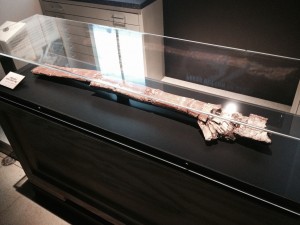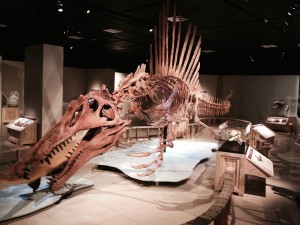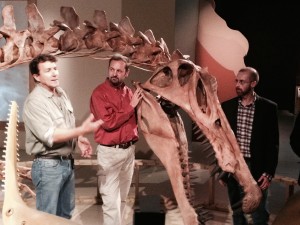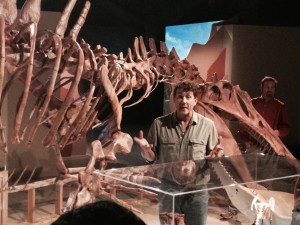“This project is a particularly good example of what National Geographic does best. National Geographic funded research with, in this case, two very talented paleontologists from the University of Chicago, and an international team… and a really rich story of science that starts a hundred million years ago, continues with the first discovery of Spinosaurus a hundred years ago, and then a modern story of discovery with new technologies.” — Kathryn Keane, vice president of National Geographic Exhibitions

The National Geographic Museum unveiled some huge news last week. You might have noticed the life-sized dinosaur towering over the museum’s courtyard in recent days, or gotten a preview of the unique looking specimen serving as cover model for the National Geographic publication’s October issue. But if you walk inside the museum doors, you can see the bone of the real thing… and even more about creatures and a habitat that were unimaginable until their remnants were uncovered in the desserts of Morocco.

The all-new and exhilarating exhibit, “Spinosaurus: Lost Giant of the Cretaceous,” is part discovery, part documentary, part mystery and all totally mind blowing. Not only does it feature a life-sized skeletal model of Spinosaurus, the largest predatory dinosaur known to have roamed the Earth (yes, measuring in at 9 feet longer than the world’s largest Tyrannosaurus rex!), the exhibition also brings to life the fascinating backstory of Spinosaurus.

“The exhibit’s chronological features help with the convoluted and dramatic story of Spinosaurus,” admitted University of Chicago paleontologist Nizar Ibrahim, a 2014 National Geographic Emerging Explorer. “The first Spinosaurus fossils were found almost 100 years ago in the desert of Egypt by a German paleontologist…Ernst Freiherr Stromer von Reichenbach.”
Tragically, during the April 1944 Allied bombing of Munich, Stromer’s important fossil collection was completely destroyed. Only some sketches and photos survived. But through a fascinating series of events, Ibrahim, alongside Paul Sereno, head of the University of Chicago’s Fossil Lab, and a team, were able to track down archives and other publications to document the first finding when a bone similar to those in Stromer’s sketches turned up unexpectedly.

New Spinosaurus fossils were discovered in the Moroccan Sahara along desert cliffs known as the Kem Kem beds. Once a large river system, this area was home to a variety of aquatic life, including large sharks, coelacanths, lungfish and crocodile-like creatures, along with giant flying reptiles and predatory dinosaurs.
“This exhibition is a fascinating tale of modern discovery and a trip back 95 million years in time to what was probably the most dangerous place on Earth,” said Kathryn Keane, vice president of National Geographic Exhibitions. “Thanks to science, we now know that the windswept and barren Sahara was once teeming with gigantic and terrifying predatory creatures, and Spinosaurus was the biggest and the baddest of them all.”
Museum visitors will follow the saga of Spinosaurus all the way from Stromer’s Munich office during the turbulence of World War II to Sereno’s Fossil Lab in present-day Chicago. The interactive, multimedia exhibit takes visitors on a journey spanning decades and continents, culminating with the reveal of the massive skeletal model of Spinosaurus, displayed alongside other discovered species from the Cretaceous period.
“Stromer found more than Spinosaurus,” Sereno explained at the exhibit opening. “All of these animals… here lived with Spinosaurus. The jewel of his description – the most bizarre dinosaur – [gave] us bits and pieces… it hadn’t given us the Rosetta Stone specimen… but it led us to the Star Ship Enterprise.”
The big finale after scientist’s first opportunity to study these creatures’ fossils in modern times with modern methods? “Spinosaurus is the first dinosaur ever to show adaptation for living in water. That is a big statement. This dinosaur really cuts a new mold.”
The global search to uncover the Spinosaurus skeleton and its mysteries isn ow on public view at the National Geographic Museum. It will also be featured in a National Geographic/NOVA special, “Bigger Than T.rex,” airing on PBS Nov. 5, 2014, at 9 p.m.




